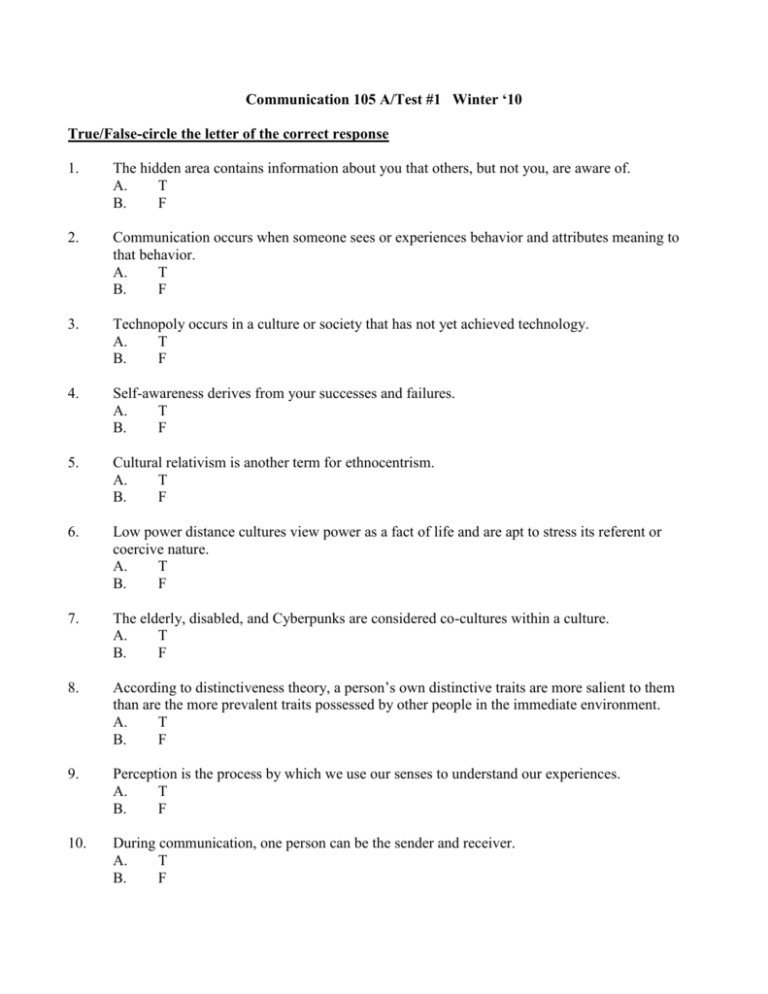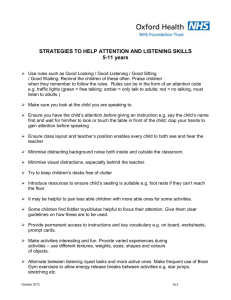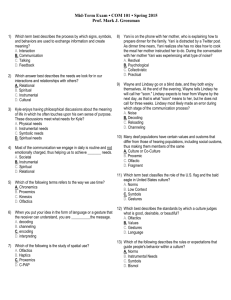Communication 105 A-Test #1
advertisement

Communication 105 A/Test #1 Winter ‘10 True/False-circle the letter of the correct response 1. The hidden area contains information about you that others, but not you, are aware of. A. T B. F 2. Communication occurs when someone sees or experiences behavior and attributes meaning to that behavior. A. T B. F 3. Technopoly occurs in a culture or society that has not yet achieved technology. A. T B. F 4. Self-awareness derives from your successes and failures. A. T B. F 5. Cultural relativism is another term for ethnocentrism. A. T B. F 6. Low power distance cultures view power as a fact of life and are apt to stress its referent or coercive nature. A. T B. F 7. The elderly, disabled, and Cyberpunks are considered co-cultures within a culture. A. T B. F 8. According to distinctiveness theory, a person’s own distinctive traits are more salient to them than are the more prevalent traits possessed by other people in the immediate environment. A. T B. F 9. Perception is the process by which we use our senses to understand our experiences. A. T B. F 10. During communication, one person can be the sender and receiver. A. T B. F 11. Cultural nearsightedness is the failure to understand that we do not all attribute the same meanings to similar behavioral clues. A. T B. F 12. Present experiences often provide us with expectations, or perceptual sets, that affect how we process our world. A. T B. F 13. The term stereotype is derived from a printing practice in which the typesetter repeatedly uses the same type to print text. A. T B. F 14. Chronemics is the study of the use of space and distance between people. A. T B. F 15. Words stand for, or represent things but are not necessarily the things they stand for. A. T B. F 16. Bypassing is a pleasant word that is substituted for a less pleasant one. A. T B. F 17. The use of personal adornments, such as beards or jewelry is called artifactual communication. A. T B. F 18. The open self represents information about ourselves that others know but you do not. A. T B. F 19. Researcher Ralph Nichols said most of us actually listen at only 25% efficiency. A. T B. F 20. Cultural differences in listening styles and behavior demands that Americans become more aware of the listening variations found in other cultures. A. T B. F Multiple choice-circle the correct answer 21. Communication occurs when one (or more) persons sends and receives messages that: A. Are distorted by noise B. Occur within a context C. Provide some opportunity for feedback D. All of the above E. None of the above 22. Communication allows us to satisfy our ____________ by allowing us to feel that we are capable and responsible, that we are able to deal with and manage our environment. A. Need for Inclusion C. Need to be Free B. Need for Affection D. Need for Control 23. Failing to develop insights into cultural nuances and differences is considering being: A. Rude B. Ethnocentric C. Culturally confused D. Stubborn 24. ________ are composed of members of the same general culture who differ in some ethnic or sociological way from the parent culture. A. Collectivists B. Co-Cultures C. Individualists D. None of the above 25. Superiors and subordinates from low power distanced cultures emphasize: A. Interdependence by displaying a preference for consultation B. Stress coercive or referent natures C. View power as a fact of life D. Subordinates are quick to give in to superiors E. None of the above 26. In any interactional situation, we cannot avoid communicating. This illustrates which of the following about communication? A. That it is unrepeatable B. That it is irreversible C. That it is inevitable D. None of the above 27. Perceptual sets are past experiences that provide us with expectations that are formed from: A. Our culture B. Motivation C. Education D. All of the above 28. A first impression, or __________ can affect the perception and the result of communication. A. Recency effect B. Free for all effect C. Primacy effect D. Unknown effect E. None of the above 29. When we apply the judgment to all members of a group, and fail to acknowledge the uniqueness of the individual, we are acting within the process of: A. Self-serving bias B. Prejudice C. Dialectical tension D. Stereotyping 30. Which factors influence self-disclosure? A. Who your listeners are B. Who you are C. The topic of the impending self-disclosure D. All of the above E. None of the above 31. When our perception of another changes for the worse, we are likely to see only his or her negative qualities. This is called: A. The halo effect B. The cultural effect C. The horn effect D. This does not have an effect 32. _______stand for, or represent things but are not the things they stand for. A. Symbols B. Triangles C. Words D. Meanings 33. Racial code words such as “you people” and “one of them” help: A. Create a racially hostile environment B. Create a friendly environment C. Create a neighborly environment D. None of the above 34 The book states that disclaimers are remarks that diminish a statement’s importance and are: A. Utilized more by kids B. Utilized more by men C. Utilized more by women D. None of the above E. Utilized by couples in love 35. The concept utilized in nonverbal communication with distance is? A. Olfactics B. Chronemics C. Proxemics D. Pupilmetrics E. All of the above 36. “Shifty eyes”, “evil eye”, and the “look of love” are part of eye communication which: A. Are in the category of Facial Management Technique B. Are bypassing of meaning C. Depends on context D. All of the above E. None of the above 37. The use of personal adornments such as T-shirts, beards, jewelry is our use of: A. Dressing up C. Regulators B. Artifactual Communication D. Crisscrossing 38. Listening to understand the feelings of the speaker is: A. Empathic Listening C. Critical Listening B. Appreciative Listening D. Sexist Listening 39. A prerequisite for effective listening is: A. Speaking B. Feedforward 40. C. D. Walking Feedback Your Professor has a collection of all of these cultural artifacts except for: A. A Buddha C. A bullfighter B. A boa constrictor snake D. A Moroccan monetary bill Short Essay-write a descriptive paragraphs for EACH of these three topics 10 points Explain what is meant by the statement, “communication is inevitable, irreversible, and unrepeatable.” Distinguish these three features of communication through examples taken from your everyday life. 5 points The scene in the movie “The Blackboard Jungle” that we watched in class depicted several elements of communication. List one and explain how this element was effective in the movie. 5 points Define olfactics and chronemics and provide an example for each term. USE THE BACK SIDE OR ATTACH AN ADDITIONAL SHEET IF NECESSARY->






